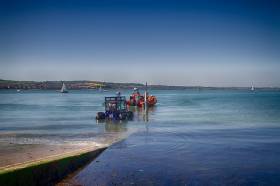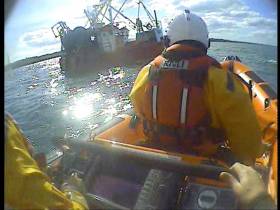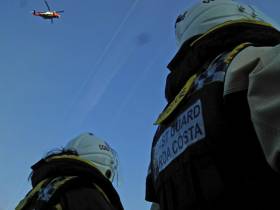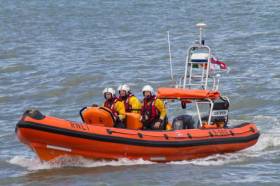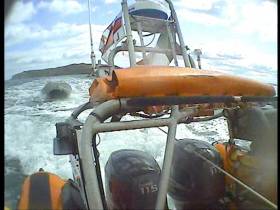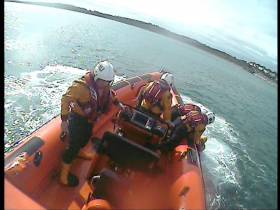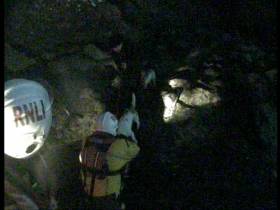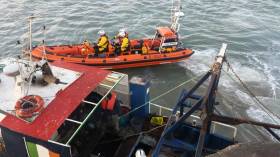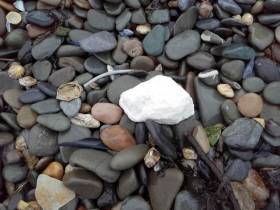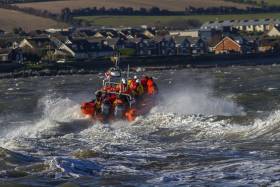Displaying items by tag: Skerries
Fine Weather Means Busy Weekend For Skerries Lifeboat
#RNLI - Skerries RNLI volunteers were tasked on three separate occasions last weekend with the pagers sounding once on Saturday (17 June) and twice on Sunday (18 June).
Shortly after 3pm on Sunday afternoon, Dublin Coast Guard received reports that a number of people were in the water having been cut off by the rising tide.
Skerries RNLI were tasked and the volunteers launched their Atlantic 85 inshore lifeboat with Conor Walsh at the helm and crewed by Stephen Crowley, Steven Johnston and Peter Kennedy.
The lifeboat was on scene within a matter of minutes and immediately located a man and woman struggling to make their way ashore.
The man was chest deep in water while the woman was holding on to his shoulders and kicking her legs to stay afloat.
They were assisted into the lifeboat where the crew began first aid assessments and protected them from the elements.
Once it was established that all others in their group had made it safely ashore, the lifeboat brought the man and woman back to the station where they were further assessed.
They were cold from having been in the water for a length of time, but were otherwise unharmed. After a period of monitoring, they left the station safe and well.
The previous afternoon, Skerries RNLI were tasked by Dublin Coast guard around 4.30pm after a member of the public reported a child in an inflatable boat drifting out to sea near Gormanston.
The lifeboat was launched and proceeded to make their way to the location given. However, while they were en route they received an update that some swimmers in the area had managed to help the child ashore and the lifeboat was stood down.
Late on Sunday evening, the pagers sounded for the third time in two days, after a call was received by Dublin Coast Guard informing them that a man in a distressed state had entered the water in Rush.
However, before the lifeboat could be put to sea our volunteers were stood down as the man had been safely assisted ashore.
Speaking about the callouts, Skerries RNLI lifeboat press officer Gerry Canning said: “We’ve been enjoying some fantastic weather lately. This means we may have more people making the most of our coastline.
“We’d encourage anyone visiting the area to check the local tides and always be aware of their surroundings and the dangers they might present.”
Skerries Lifeboat Launches To Trawler In Distress
#RNLI - Skerries RNLI launched on Tuesday evening (30 May) after the Irish Coast Guard received reports of a distress flare fired from a trawler near Balbriggan.
The lifeboat — with helm David Knight and crew Stephen Crowley, AJ Hughes and JP Tanner — proceeded towards Balbriggan Harbour, where they soon spotted a fishing trawler with another fishing vessel alongside and went to investigate.
The fishing trawler had suffered a serious electrical problem and lost all power, lowering anchor and firing a flare to signal that they required help. The second fishing vessel had responded to the distress call and come to their assistance.
With the low tide making entrance to Balbriggan Harbour difficult, the broken-down trawler was taken under tow by the lifeboat and brought to the safety of Skerries Harbour.
Speaking after the callout, Skerries RNLI lifeboat press officer Gerry Canning said: “It doesn’t matter how prepared you are, things can go wrong at sea. Thankfully they were carrying flares and didn’t hesitate to use them to raise the alarm.
“We’d also like to say well done to the other vessel that responded immediately to the call for help.”
The incident came just days after a fishing vessel sank off Skerries, taking the life of one of its two crew, as previously reported on Afloat.ie.
#MCIB - The Marine Casualty Investigation Board (MCIB) will this week begin its inquiry into the sinking of a fishing vessel off Skerries last Friday (26 May) that claimed the life of a local fisherman, according to The Irish Times.
Garda divers recovered the body of 28-year-old Jamie McAllister on Saturday morning, not far from where the fishing trawler went down off the North Dublin coast as previously reported on Afloat.ie.
His crew mate and uncle Keith McAllister was rescued at the scene — and it’s expected that the MCIB will seek an interview this week regarding the circumstances of how their vessel sank while the pair were fishing for razor clams in Force 4 winds.
Earlier this year the five-strong crew of a razor clam vessel fishing in similar conditions were rescued off the nearby Balbriggan coast after their trawler ran aground.
The MCIB previously concluded that dredge fishing for razor clams carries a “high risk” of fouling gear or snagging heavy objects, in its report on the capsize of a fishing boat in Rosslare Harbour in 2015.
Skerries RNLI Launches To Motor Boat In Difficulty
#RNLI - Skerries RNLI assisted a motor boat with two men aboard that was experiencing engine difficulties at Rockabill Lighthouse on Sunday afternoon (7 May).
Dublin Coast Guard tasked Skerries RNLI shortly after 12.30pm after receiving a call from a motor boat that was having difficulty getting their engine to start.
The lifeboat was launched with volunteer Philip Ferguson at the helm and crewed by Paddy Dillon, Steven Johnson and JP Tanner.
They proceeded on a course to Rockabill, and once on scene they located a 5m motor boat with two men on board that had become entangled in a lobster pot.
Following some troubleshooting advice from the lifeboat helm, a former RNLI mechanic, the men managed to successfully restart the engine. The lifeboat then stood by while they tested that everything was running smoothly.
With the men happy to be on their way again, the lifeboat returned to base and was made ready for the next call out.
Lifeboat press officer Gerry Canning said: “Sometimes, even though you are fully prepared you can just be unlucky. In this case their luck changed quickly as Philip used his experience to get them moving again. Our volunteers are always ready to help in whatever way they can.”
#RNLI - Skerries RNLI were tasked yesterday afternoon (15 April) to a small motor boat with three on board that had failed to return to port as expected.
Dublin Coast Guard tasked Skerries RNLI shortly after 1pm after receiving a 999 call from a member of the public who was concerned about a small motor boat that had gone to sea in the early hours of the morning.
There were three men on board the boat, and with the sea conditions changing and the wind increasing, there were concerns for their safety.
The Atlantic 85 inshore lifeboat Louis Simson was launched with Joe May at the helm and with crew members Stephen Crowley, Paddy Dillon and Jack Keane.
As the lifeboat made its way towards Rush Harbour where the men had been seen launching, they received a call from Eoin Grimes, a volunteer helm, who was at sea on board his on boat and had spotted a vessel fitting the description near Lambay Island.
Grimes soon after confirmed that the vessel was still in the area and located at the North Cardinal mark off Lambay.
The lifeboat made its way directly to the position indicated and spoke to the men on board the vessel. They agreed that the conditions had changed significantly and were going to make for the shore. The lifeboat stood by but after a few minutes, it became apparent that they were not making any progress under their own power.
The three men were taken on board the lifeboat and their boat was taken under tow for a safe return to Rush Harbour.
Speaking after the callout, Skerries RNLI lifeboat press officer Gerry Canning said: “We would encourage anyone going to sea to always check the forecast, wear lifejackets, carry a means of calling for help and let somebody on shore know when you expect to return.”
#RNLI - Skerries RNLI rescued a swimmer in difficulty yesterday afternoon (Tuesday 11 April) after he encountered a strong tide near Shenick Island and was unable to make his way ashore.
Dublin Coast Guard tasked Skerries RNLI shortly before noon after receiving an emergency call from a member of the public who had spotted a swimmer struggling to make any progress against the tide at the island off Skerries.
Volunteers launched the Atlantic 85 inshore lifeboat Louis Simson, with David Knight at the helm and crew Philip Ferguson, Joe May and Laura Boylan.
The lifeboat proceeded to the area indicated by the caller, where an Irish Coast Guard helicopter had also arrived on scene. They took the male casualty on board the lifeboat, protected him from the elements, and began first aid assessments as they made their way back to the station.
The casualty had swallowed seawater during his efforts to swim to shore and as a result, on the advice of the crew, he was transferred by ambulance to hospital for further assessment.
Speaking after the callout, Skerries RNLI lifeboat press office Gerry Canning said: “We’ve had a couple of tidal-related incidents in the last few days. We’d just like to remind people that the strength and height of the tide varies throughout the month.
“We would strongly recommend checking tide tables before engaging in any activity on or near the sea.”
Skerries Lifeboat Rescues Dogs & Owners From Rising Tide
#RNLI - Skerries RNLI rescued a man and a woman and two dogs on Sunday evening (9 April) after they had been stranded on rocks by the rising tide in Loughshinny.
Dublin Coast Guard tasked Skerries RNLI shortly before 9pm on Sunday evening, having received a 999 call from two people who had been cut off by the tide.
The lifeboat was launched with volunteer Eoin Grimes at the helm and crewed by Paddy Dillon, Emma Wilson and Peter Kennedy.
Making their way directly to Loughshinny Harbour, the lifeboat crew began a search of the immediate area. They spotted the casualty on the rocks using the light on a mobile phone to signal for help.
The casualties were taken on board the lifeboat and dropped back to the harbour, where they were met by volunteers from Skerries Coast Guard unit.
Conditions at the time were moderate with a Force 3 to 4 northerly wind.
Speaking about the callout, Skerries RNLI lifeboat operations manager Niall McGrotty said: “We’d like to remind everyone making the most of the coast in the good weather to always check the tides and forecast for the area and to carry a means of calling for help.”
Skerries Lifeboat Rescues Four People & A Dog In Busy Week
#RNLI - Skerries RNLI responded to three calls for help since the weekend, bringing to safety three men, a woman – and a dog.
Dublin Coast Guard tasked Skerries RNLI shortly after 6.30am yesterday morning (Wednesday 1 March) after a call from a fishing vessel with two men on board that had run aground on the rocks south of Shenick Island.
The inshore lifeboat crew quickly located the fishing boat and determined that she was still aground, but not taking on any water.
As a precaution, Howth RNLI’s all-weather lifeboat was requested to assist, but as the vessel began to float no help was required and the Howth crew returned to station.
The Skerries lifeboat — with helm Eoin Grimes and crew Paddy Dillon, Steven Johnson and Peter Kennedy — stood by the fishing vessel as she returned safely to Skerries Harbour.
Two days previously, on Monday morning (27 February) shortly after 10.30 am, volunteers Conor Walsh, Joe May and Stephen Crowley manned the lifeboat to assist a woman who was stranded on the rocks after going to the aid of a trapped dog.
The woman was not the owner of the dog, but had waded out to help the distressed animal before being cut off by the tide.
Both were brought safely to the lifeboat station and the dog was taken to a local veterinarian, where she was later reunited with her owner.
On Saturday afternoon (25 February), the lifeboat was launched with Eoin Grimes, Conor Walsh and Simon Shiels on board after the coastguard requested assistance for a man who had lost power on his personal watercraft.
The man had been some way off shore when he ran into difficulty, and was exhausted after he had managed to paddle a long distance.
The lifeboat crew assisted the man ashore where he received further help from the Skerries Coast Guard unit. They then took the watercraft under tow and returned it to the beach.
Speaking about the callouts, Skerries RNLI lifeboat press officer Gerry Canning said: “We’re very proud of our volunteers. This last few days they have shown just how much commitment and dedication is involved in being on call 24 hours a day, 365 days a year. They are always ready to respond to a call for help.”
Fingal Council Urges Vigilance Over Palm Oil ‘Fatbergs’
#CoastalNotes - Fingal County Council has issued a warning for people to be vigilant for palm oil ‘fatbergs’ along the North Dublin coast as they can be particularly dangerous to dogs.
A number of fatty balls were found on Sunday (12 February) at Hoare’s Rock in Skerries, Co Dublin, and results from laboratory tests have showed that the substance was palm oil.
It’s thought that the oil was part of a consignment which came off a ship in the English Channel about 18 months ago and was washed ashore by the weekend storm.
The congealed substance has been turning up sporadically on beaches and coasts in England but this is the first time it has been recorded in Fingal.
Similar fatty deposits washed up on Mayo beaches last November, as previously reported on Afloat.ie.
“We believe the discovery of this material in Skerries on Sunday is an isolated incident as we have not had any other sightings along the Fingal coastline,” said a council spokesperson.
“The material is a solid white substance which is known as a ‘palm oil fatberg’ and they can range in size from being as  small as a golf ball to as big as a boulder.
“We are asking the public to be vigilant as this substance can be harmful to dogs.”
Second Callout In Two Days For Skerries Lifeboat
#RNLI - Skerries RNLI volunteers launched their Atlantic 85 inshore lifeboat Louis Simson for the second time in two days on Tuesday evening (29 November 29) after Dublin Coast Guard received reports from a fishing vessel of a boat on fire.
Shortly before 9pm a fishing vessel contacted Dublin Coast Guard and reported seeing a boat on fire, providing GPS co-ordinates for the location.
The lifeboat, with Emma Wilson at the helm and crewed by Joe May, Philip Ferguson and Ian Guildea, made its way directly to the area indicated.
Once on scene they carried out an initial search but there were no vessels in the immediate area. There was however, a marine survey vessel operating in the area with bright orange working lights.
After a further search it was decided that it was a false alarm with good intent and the lifeboat was stood down.
Speaking after the callout, Skerries RNLI lifeboat press officer Gerry Canning said: “The crew of the fishing vessel genuinely believed that there was someone in danger and contacted Dublin Coast Guard.
“Our volunteers will respond to any call for help, 24 hours a day, 365 days a year.”
On Sunday evening (27 November) the lifeboat launched after several people dialled 999 to report sighting distress flares near Balbriggan. However, with no sign of anyone in difficulty, the lifeboat was stood down.


























